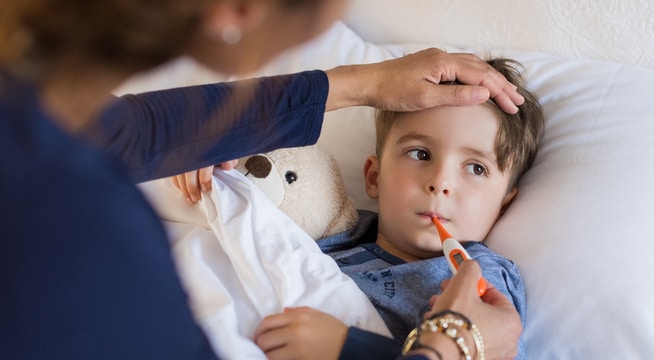Fevers in Children
Children's Health
•
Mar 12, 2019

Having children comes with plenty of trips to the doctor for vaccines, the common cold, ear infections, and the occasional Lego stuck up a nostril. And while it’s expected that kids will have minor health-related issues every now and then, parents may be confused as to when they can address a concern with over-the-counter medications and home remedies and when it’s necessary to see a doctor.
To better help you understand fevers in children, below is an overview of how to recognize a fever, and how to know when it’s time to see a doctor.
What Is a Fever and What Causes It?
The average body temperature of a healthy person is 98.6 degrees. However, when a person has an infection, the temperature will rise as the body tries to fight it.
A child’s body temperature will also rise if they have been active or are wearing several layers of clothes. However, if their temperature reaches 100.4 degrees (or 99.5 degrees for a baby), they have a fever.
Symptoms of Fever
Typically, you’ll know a child has a fever if their skin is warm or hot to the touch. However, there are additional signs that indicate a fever:
- Flushed skin
- Shivering
- Body Aches
- Excessive Sweating
- Lack of energy
- Lack of appetite
When Is a Fever Too High?
If an infant who’s younger than three months old has a fever, seek medical attention immediately. For children older than three months, a high-grade fever is 102 degrees or higher.
How to Decrease a Child’s Fever
If a child has an underlying infection that’s causing the fever, the pediatrician will likely prescribe antibiotics. However, there are additional things you can do at home to help decrease a high temperature:
- Tepid bath. You can decrease a child’s fever at home by giving them a sponge bath with lukewarm water.
- Drink fluids. Fevers often lead to dehydration. Make sure to give your child plenty of water or natural fruit juice.
- Keep the child cool. You can do this by placing a cool, wet cloth on their forehead and dressing them in light clothing.
- Rest. Allow your child to skip school, sleep in, take naps throughout the day, and avoid strenuous play.
- Ibuprofen. This will alleviate body aches that often come with a fever. Make sure to read the dosage instructions for children.
When to See a Doctor
While sometimes, fevers can be treated at home, see a doctor immediately if the child is under three months of age or experiencing any of the following:
- Difficulty breathing
- Blue lips
- Headache
- Vomiting
- Diarrhea
- Seizures
- Unresponsiveness
A note about seizures: There are two types of febrile seizures, and most of them happen to children under three years of age. When these occur, roll your child over to their side, do not restrict their movements, and do not place anything in their mouth.
Call 911 if it lasts longer than five minutes.
24-Hour Emergency Room Services in Colorado Springs and Texas
If your child has a fever, we can provide the care you need. If you have questions or need immediate treatment, your nearest Complete Care location is ready to help, no matter the time of day or night. We offer a variety of services to help you and your family in your time of need. No appointments are necessary.
Find the Complete Care location nearest you.